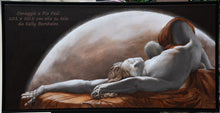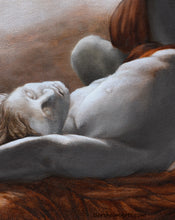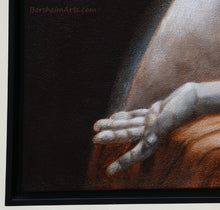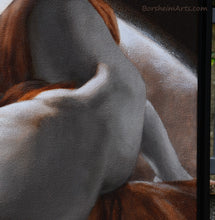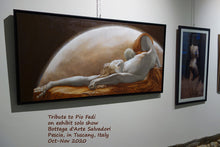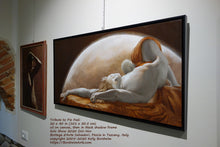
Tribute to Pio Fedi
20 x 40 in (101 x 50.5 cm)
oil on canvas, then in black shadow frame
copyright 2005-2020 Kelly Borsheim
https://BorsheimArts.com
This oil painting was inspired by the light and the curve of the front of the hip bone of this reclining nude man. His hips are higher than his shoulders. His wounded body forms a long triangle with his knees bent and up. Thus, I added the circular curve and bright light of the full moon behind the figure. His left arm is extended out to the left and his fingers relax, becoming elongated. The other hand is bent up closer to the viewer, above the head of the marble man. That hand is still in a fist, as if clinging to some weapon.
This painting is mostly monochromatic, using asphaltum, raw umber, white, and a background of burnt umber.
This painting features a tribute to Italian sculptor Pio Fedi who created a four figure composition in marble titled "Pirro che rapisce Polissena." I have seen the English translation of this title to be either "The Rape of Polyxena" (il ratto di Polissena) or "The Abduction of Polyxena." The sculpture is on display in the Loggia dei Lanzi in Firenze, Italia, in front of the Uffizi Gallery (Galleria degli Ufizzi).
Pio Fedi was an Italian sculptor (born in Viterbo in 1816; died in Firenze in 1892). The full marble (marmo) sculpture "Pirro che rapisce Polissena" was created in the years 1860-1865. (This information is what I recorded from the sign in the Loggia dei Lanzi, where the sculpture is displayed. The Loggia faces Piazza della Signoria.)
Pirro che rapisce Polissena
This sculpture depicts four figures in various phases of struggle. The dominant figure is Pirro (Pyrrhus, also called Neoptolemus, is the son of the famous Achilles). Pirro, wanting revenge for his father's death, is abducting Polyxena (the translated spelling of Polissena), the youngest daughter of the Trojan King Priam and Queen Hecuba, so that he may cut her throat over the grave of Achilles. The other figures portrayed are Polissena's pleaing mother Hecuba and her defeated brother Polites.
There are a few conflicting stories about the relationship between Achilles and Polyxena. But by all accounts that I discovered, the Greek Achilles was in love with the Trojan Polyxena and his love for her caused his demise.
My painting "Tribute to Pio Fedi" shows the slain Polites alone, his body in front of a full moon. I was drawn to this figure for many reasons, but mostly for the lovely curve of the inside front of the pelvic basin.
Images of Firenze, Italia:


Above, from Pio Fedi's marble sculpture: The image on the left is Pirro looking down with scorn upon Hecuba. To the right, you see a detail shot of Polites' face. I hope you see the tears sculpted falling from his eye.


Above: A street performing mime entertained the crowds by interacting with those walking by. Behind him, in the top row of spectators, you will see a man with a blue shirt standing next to a man wearing an orange shirt. Behind this pair stands Pio Fedi's marble composition "Pirro che rapisce Polissena".


No, this ambulance is NOT holding up a huge bronze monument -- but I enjoyed the idea. This photo is taken in the Piazza della Signoria. The Loggia dei Lanzi is in the background, to the right. The image on the right was taken in front of the Galleria degli Uffizi.






